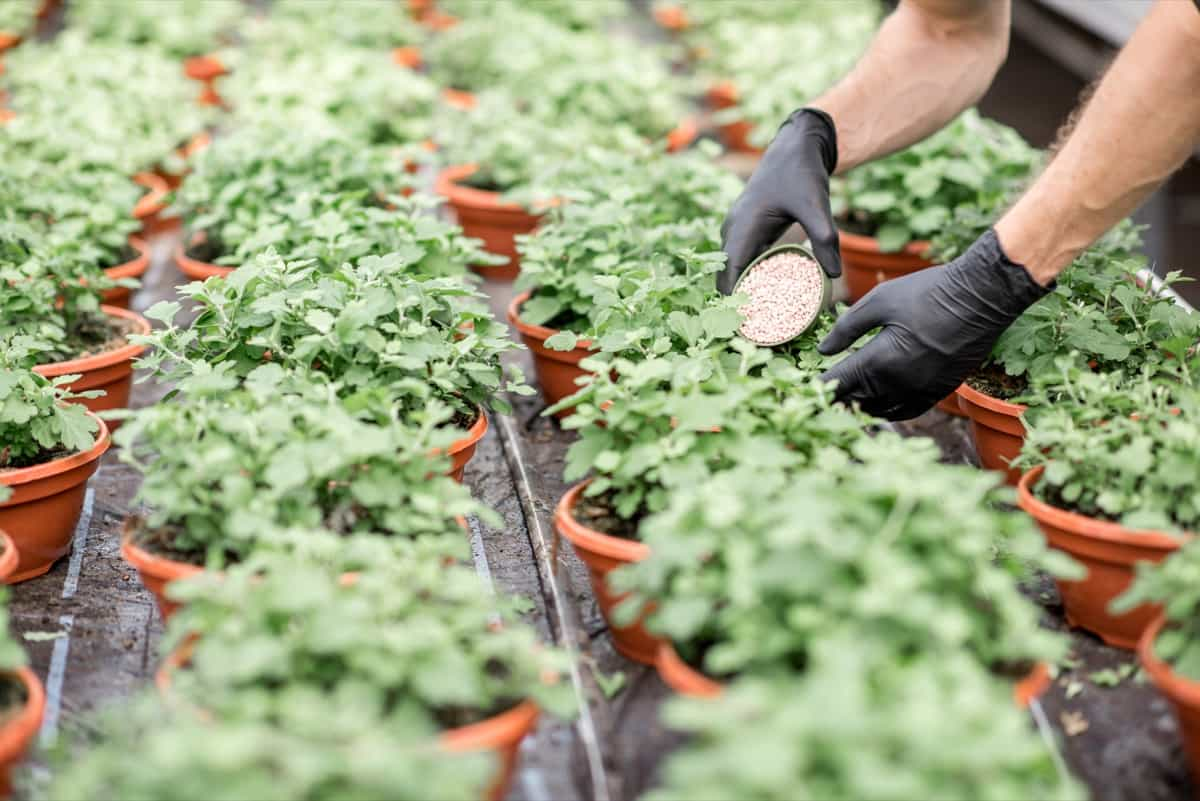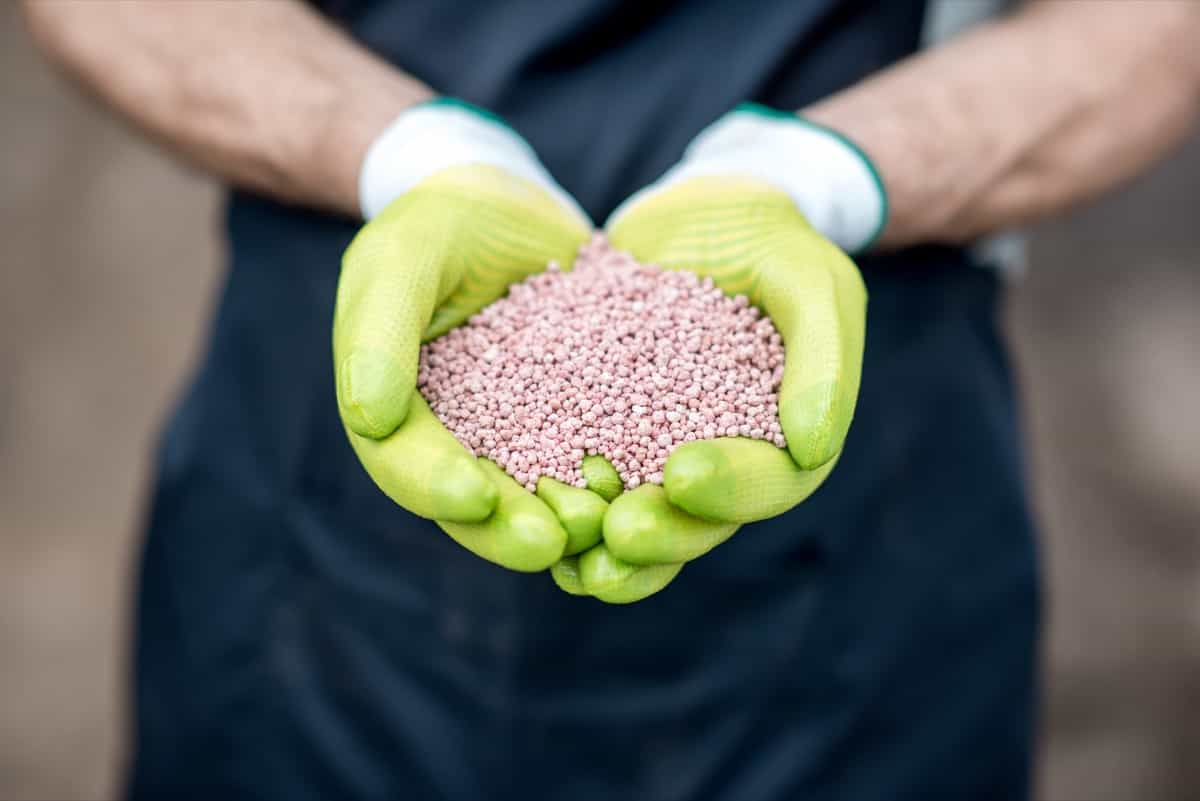Applying 14-14-14 fertilizer to your garden plants is a simple process that can provide them with the essential nutrients they need for healthy plant growth. This powerful blend is like a nutrient-packed energy drink for your garden, giving your plants the boost they need to thrive. It refers to the nutrient composition of the fertilizer. In simpler terms, it contains equal parts nitrogen (N), phosphorus (P), and potassium (K).

How to Apply 14-14-14 Fertilizer Step by Step?
- Prepare the area: Remove any weeds or debris from the soil surface before applying fertilizer. This will ensure that the fertilizer reaches your plants’ roots more easily.
- Calculate the amount needed: It’s important to determine the correct amount of 14-14-14 fertilizer required for your specific garden area. Refer to the instructions carefully on the product packaging and measure accordingly.
- Spread evenly: Start by scattering the granules across your garden beds or around individual plants, considering that over-application can harm plant roots.
- Incorporate into the soil: Gently work the granules into the top layer of soil using a rake or cultivator tool. This will help distribute nutrients more uniformly and prevent runoff during watering.
- Water thoroughly: After application, water your garden beds or potted plants deeply so that water carries these vital nutrients down toward their root systems.
Benefits of Using 14-14-14 Fertilizer for Garden Plants
One of the main benefits of using 14-14-14 fertilizer for garden plants is its balanced nutrient composition. With equal quantity of nitrogen, phosphorous, and potassium, this fertilizer boosts plant growth and development. Nitrogen is crucial in promoting healthy leaf growth and vibrant green foliage.
It helps plants produce chlorophyll, which is essential for photosynthesis. Phosphorus aids in root development and overall plant strength and contributes to flower production. Potassium regulates important processes within plants, such as water uptake and nutrient absorption. You can expect improved overall health and vigor by applying 14-14-14 fertilizer to your garden plants.
The balanced nutrients it provides ensure that all aspects of plant growth are supported effectively. This can result in lusher foliage, stronger roots, increased flower blooms, and higher yields from vegetable crops. Another advantage of using the 14-14-14 type of fertilizer is its versatility. Whether you have lawns that need greening up or potted flowers that require extra nourishment, 14-14-14 fertilizer can be used across various plants with great success.
Best Practices for Applying 14-14-14 Fertilizer in the Garden
Firstly, reading the instructions carefully before using any fertilizer is important. Before applying the fertilizer, ensure your garden soil is moist but not overly saturated. This will ensure the fertilizer’s nutrients can easily penetrate your plants’ root zone. Removing weeds or debris from your garden beds before fertilizing is also a good idea. To apply the 14-14-14 fertilizer evenly, use a handheld or broadcast spreader for larger areas.
In case you missed it: Benefits of Mineral Fertilizer Sticks: How to Use for Indoor Potted Houseplants

Start by dividing your garden into smaller sections and apply the fertilizer in straight lines across each section. Be careful not to overlap too much, leading to uneven distribution. After spreading the fertilizer, lightly water your garden beds to help activate and dissolve the nutrients. Over-application can damage plants and harm beneficial soil organisms. Follow dosage recommendations strictly and avoid excessive use.
Applying 14-14-14 Fertilizer: Dos and Don’ts
Do read the instructions carefully before applying the fertilizer. Each product may have specific recommendations regarding application rates and frequency. Following these instructions is important to avoid over or under-fertilizing your plants. Apply the fertilizer evenly across the desired area. Whether you’re fertilizing your lawn or potted plants, ensure each plant receives equal fertilizer for consistent growth and health.
Do water your plants after applying the 14-14-14 fertilizer. Water helps activate nutrients in the soil and allows them to be absorbed by plant roots more effectively. On the other hand, there are also some don’ts when it comes to using 14-14-14 fertilizer. Don’t apply too much fertilizer at once; it can burn plant roots and cause damage. Instead, stick to recommended rates based on instructions provided by manufacturers.
How Often Should I Use 14-14-14 Fertilizer on My Garden Plants?
Applying 14-14-14 fertilizer every three to four months on your lawn or garden plants is recommended. This allows for a steady supply of nutrients throughout the growing season without overwhelming the plants with excessive amounts. However, it’s important to note that you should only use this type of fertilizer during the growing seasons.
Applying it during dormant periods won’t provide any benefits and could potentially harm your plants. Before applying the fertilizer, be sure to read all instructions provided by the manufacturer carefully. Following these guidelines will ensure you use the product correctly and achieve optimal results.
Understanding the Nutrient Composition of 14-14-14 Fertilizer
It is crucial for any gardener looking to give their plants a healthy boost. This balanced fertilizer contains equal amounts of nitrogen (N), phosphorous (P), and potassium (K), with each element making up 14% of its composition. Nitrogen is vital in stimulating leafy growth, while phosphorus promotes strong root development and flower production.
Potassium helps improve overall plant health by enhancing disease resistance and water uptake. By having an equal proportion of these essential nutrients, 14-14-14 fertilizer ensures that plants receive a well-rounded supply of NPK elements. This balance is particularly beneficial when plants have high nutritional demands during the growing season.
In case you missed it: Strawberry Fertilizer Requirements and Recommendations: Management for Optimal Yield

Maximizing the Effectiveness Of 14-14-14 Fertilizer in Your Garden
Apply the fertilizer during the growing season when your plants need it the most. This will ensure they receive an instant boost of essential nutrients to support healthy growth. After applying 14-14-14 fertilizer, make sure to water your plants thoroughly. This helps dissolve and activate the nutrients, allowing them to penetrate deep into the soil where roots can easily access them.
Over-application can harm your plants rather than benefit them. Follow package instructions carefully and avoid excessive use. Don’t neglect soil testing and regular plant health monitoring throughout the growing season. Understanding your soil’s nutrient levels and adjusting accordingly will help optimize the benefits of 14-14-14 fertilizer for long-term plant health.
Using 14-14-14 Fertilizer to Promote Healthy Plant Growth
This balanced formula gives plants essential nutrients to thrive and reach their full potential. Your plants receive a well-rounded diet with equal nitrogen, phosphorus, and potassium. The nitrogen in the fertilizer is crucial in promoting lush foliage growth. It helps produce chlorophyll, responsible for photosynthesis and overall plant health. Phosphorus supports root development and encourages strong flower and fruit production. Potassium aids in disease resistance, drought tolerance, and overall stress management.
To maximize its effectiveness, water your plants thoroughly after application. This will help dissolve the nutrients into the soil where roots can easily access them. Regularly watering your plants after fertilizing prevents burning or damaging their delicate roots. Remember that too much fertilizer application can harm your plants as excess nutrients can lead to imbalances or even burn their roots. Therefore, always apply according to the guidelines provided on product labels.
The Role Of 14-14-14 Fertilizer in Improving Soil Fertility
By providing these vital nutrients in balanced proportions, 14-14-14 fertilizer helps replenish depleted soils. Over time, continuous use can enhance soil fertility by restoring crucial elements necessary for optimal plant growth. Additionally, this type of fertilizer encourages microbial activity in the soil, further improving plant nutrient availability.
Another advantage lies in how 14-14-14 fertilizer promotes sustainable agriculture practices. Ensuring that crops receive adequate nutrition throughout their lifecycle reduces reliance on synthetic chemicals or excessive amounts of fertilizers later on. This not only saves costs but also minimizes environmental impact.
In case you missed it: Benefits of Using 15-15-15 Fertilizer in Your Garden: When and How to Apply

Conclusion
Applying 14-14-14 fertilizer correctly is crucial to maximize its effectiveness. This fertilizer can be used on various plants, including lawns, vegetables, flowers, and potted plants. Its versatility makes it a popular choice among gardeners looking to nourish their entire garden or specific areas that need extra attention.
- Feed Your Flock for Less: Top 10 Tips to Save on Chicken Feed
- Ultimate Guide to Ossabaw Island Hog: Breeding, Raising, Diet, and Care
- Hatching Answers: The Top 10 Reasons Your Chickens Aren’t Laying Eggs
- Eggs and Economics: Breaking Down the Cost of Raising Backyard Chickens
- Defend Your Greens: Proven Methods to Keep Iguanas Out of Your Garden
- Ultimate Guide to Cinnamon Queen Chicken: A Comprehensive Guide for Beginners
- Ultimate Guide to California Tan Chicken: Breeding, Raising, Diet, Egg-Production and Care
- Ultimate Guide to Marsh Daisy Chicken: Breeding, Raising, Diet, and Care
- 10 Types of Chicken Farming Businesses You Can Start for Profits